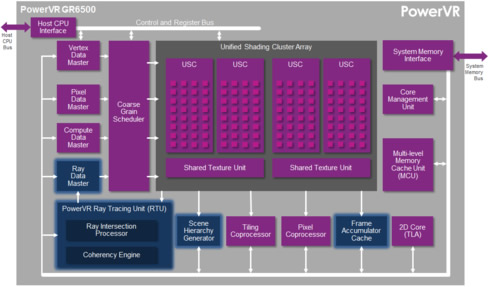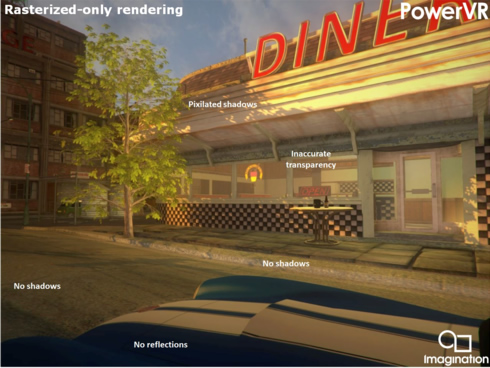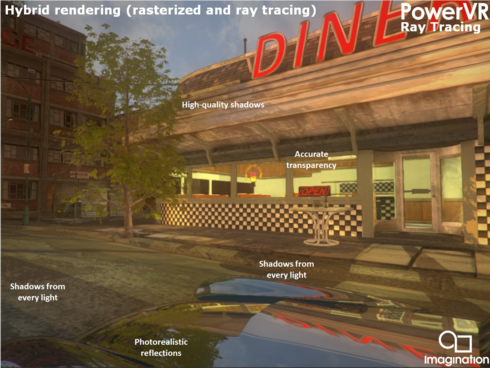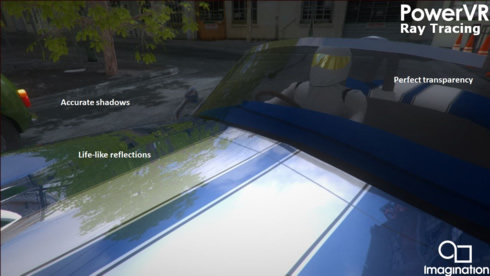 Imagination Technologies has announced at GDC 2014 the official launch of the PowerVR Wizard GPU family, a range of IP processors that offer high-performance ray tracing, graphics and compute in a power envelope suitable for mobile and embedded use cases.
The first member of the Wizard family is PowerVR GR6500.
This ray tracing processor is based on a latest generation,
quad-cluster PowerVR Rogue design, with all the bells and whistles of
the recently-launched PowerVR Series6XT GPU processors, including:
Imagination Technologies has announced at GDC 2014 the official launch of the PowerVR Wizard GPU family, a range of IP processors that offer high-performance ray tracing, graphics and compute in a power envelope suitable for mobile and embedded use cases.
The first member of the Wizard family is PowerVR GR6500.
This ray tracing processor is based on a latest generation,
quad-cluster PowerVR Rogue design, with all the bells and whistles of
the recently-launched PowerVR Series6XT GPU processors, including:
- Full-blown graphics and compute performance: four Unified Shading Clusters (USCs), with 128 ALU cores delivering more than 150 GFLOPS (FP32) or 300 GFLOPS (FP16) at 600 MHz
- Real-world ray tracing performance: Up to 300 MRPS (million rays per second), 24 billion node tests per second and 100 million dynamic triangles per second at 600 MHz
- PowerGearing G6XT for advanced power management and dynamic resource allocation
- PVR3C triple compression technologies (PVRTC and ASTC for texture
compression, PVRIC for frame buffer compression, PVRGC for geometry
compression)
- Deep Color support for very high image quality at Ultra HD resolutions and beyond
PowerVR GR6500 is designed to provide leading support for a range of APIs such as OpenGL ES 3.1/2.0/1.1, OpenGL 3.x, Direct3D 11 Level 10_0, OpenCL 1.2, and OpenRL 1.x.

On top of the features listed above, PowerVR GR6500 includes
additional ray tracing-specific hardware that provides full hardware
acceleration of the entire ray tracing flow, including model building
and traversal:
- a dedicated ray tracing data master that
feeds ray intersection data to the main scheduler, in preparation for
shaders to run, which evaluate the ultimate data contribution from the
ray.
- a specialized Ray Tracing Unit (RTU) which
uses fixed-function math to perform ray tracing intersection queries,
in addition to gathering ray coherency in order to reduce power and
bandwidth consumption.
- a scene hierarchy generator to speed up dynamic object updates.
- a frame accumulator cache that provides write-combining scattered access to the frame buffer.
Imagination says that all of these ray tracing-specific elements have been designed to
integrate efficiently and communicate perfectly with the rest of the GPU
architecture and produce real-time, interactive ray traced graphics
that can scale from mobile and embedded platforms to gaming
consoles and mainstream gaming PCs.

This night scene uses hybrid rendering running on PowerVR Ray Tracing hardware
More importantly, these blocks do not affect the shading performance
of the traditional graphics pipeline because they do not use up shading
GFLOPS to perform ray tracing-related tasks. The company says that the PowerVR GR6500 is able to perform ray tracing tasks 100x more efficiently compared to using GPU compute or other software-only approaches on traditional graphics architectures.
For all those not familiar with Ray tracing, it is a technique for rendering 3D graphics with complex and
more natural lighting models to achieve cinema-quality images and near photographic realism. To-date, ray tracing has been used in specialised applications such
as special effects and computer animated movies, industrial design,
mechanical and architectural modelling to create lifelike and
photorealistic imagery.

This is a model created by Mads Dr"Ø"schler using our PowerVR Ray Tracing technology
Ray tracing is also used today by tools, to
create the pre-baked lighting maps that are delivered with most games.
The latest generation Unity 5 game engine announced at GDC 2014 embeds
our PowerVR Ray Tracing software technology for interactive real-time
lightmap previews. Ray tracing offers artists the ability to accurately
simulate the behaviour of light and instantaneously visualize the subtle
lighting effects of any tweak to their game assets.

The Unity 5 lightmap editor uses PowerVR Ray Tracing technology to improve pre-baked lighting
The ray tracing approach can provide substantial benefits when used
for real-time rendering in game engines too. PowerVR Wizard GPUs allow
the coexistence of traditional polygon based rendered objects (e.g.
objects created using OpenGL ES) and lifelike ray-traced elements in the
same scene.

Traditional, rasterized-only rendering cannot model light transport accurately

PowerVR Ray Tracing GPUs offer ultra-realistic shadows, reflections and transparency at no extra cost
Another example is improving game AI; for example, characters
in a first-person shooter can start to see and understand the 3D environment around them, using the ray tracing to process spatial
understanding opens up a new world for realistic behavior when in-game
agents can make decisions based on direct line of sight calculations
that model what they are able to see.
The ability of GPUs to claim millions of rays per second is not a new
concept. For example a current-generation, desktop-class ray tracer
using GPU compute and rendering a very simple scene, resident in a tiny
cache, might be able to deliver millions of rays per second in a very
simple shading scenario.
However, in 99% of real world cases, those aren?t useful rays;
additionally, you would need a power budget upwards of 300W to achieve
anything remotely close to the performance that PowerVR Ray
Tracing-based hardware achieves.

PowerVR Wizard ray tracing GPUs provide the performance required to produce photorealistic effects in games
This is because all GPUs are parallel processing engines: multiple
threads all execute the same instruction. This works great for vertex
and pixel processing workloads. High coherency between threads is
essential for efficiency and non-coherent execution paths (the
appearance of divergent branches) results in masked out operations and
lost GFLOPS of performance.
Realistic ray tracing typically results in non-coherent processing
because of the way light behaves in the real world. Because light
scatters everywhere, it is very difficult to maintain coherency between
threads performing ray tracing. This is why ray tracing is not a
good match for traditional GPU architectures.
This is where PowerVR GR6500 steps in, according to Imagination Technologies: the PowerVR
Wizard ray tracing GPU provides a budget of 300 million of rays per
second in a mobile power envelope and is designed to sustain
real-world applications with highly incoherent rays, enormous scenes,
and shaders that execute hundreds of instructions to resolve each ray
(not just technical demos.)BR>